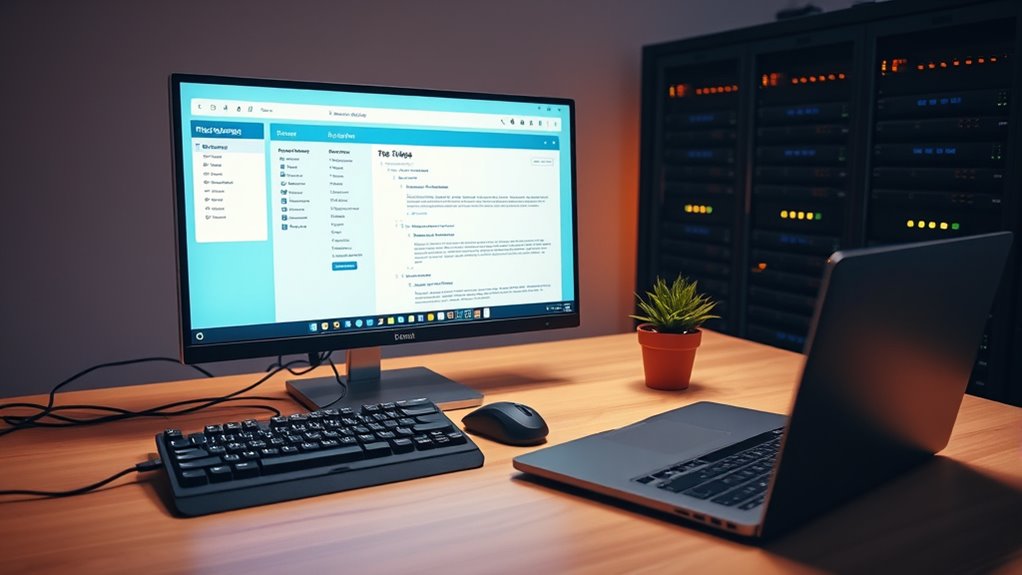To set up email on your VPS without becoming a spam magnet, you need to implement essential authentication methods like SPF, DKIM, and DMARC to verify your emails’ legitimacy. Use a dedicated IP and regularly review your sending reputation and logs. Avoid mass emails without segmentation and always include unsubscribe options. Proper configuration and ongoing monitoring help maintain your sender reputation and improve deliverability, and if you continue, you’ll discover more tips for a successful setup.
Key Takeaways
- Implement SPF, DKIM, and DMARC records to authenticate your emails and prevent spoofing.
- Use dedicated IP addresses to isolate your sending reputation and reduce spam risk.
- Maintain a clean email list by avoiding bulk sending to unverified or inactive recipients.
- Include clear unsubscribe options in your emails to comply with regulations and reduce spam complaints.
- Regularly monitor email delivery reports and authentication logs to identify and resolve spam-related issues.

Are you ready to set up email on your VPS? If so, you’re taking an important step toward managing your own mail server, but it’s essential to do it right to avoid ending up in spam folders or, worse, being flagged as a spammer yourself. One of the key areas to focus on is email authentication. Proper email authentication methods like SPF, DKIM, and DMARC help verify that your emails are legitimate and genuinely from you, which is critical for spam prevention. Without these measures, your emails might be rejected or marked as suspicious by recipient servers, making it harder for your messages to reach your audience effectively.
Setting up email on your VPS requires proper authentication to ensure deliverability and avoid spam filters.
Start by configuring SPF (Sender Policy Framework). This involves adding a DNS TXT record that specifies which servers are authorized to send emails on your behalf. It’s a straightforward step but vital for establishing trust with recipient servers. Once in place, SPF helps prevent others from spoofing your domain, which is a common tactic used in spam and phishing attacks. Next, set up DKIM (DomainKeys Identified Mail). DKIM adds a digital signature to your emails, allowing receiving servers to verify that the message hasn’t been altered during transit. This not only boosts your email’s credibility but also considerably improves your spam prevention efforts. You’ll need to generate a DKIM key, add it as a DNS record, and ensure your mail server signs outgoing messages with it.
Finally, implement DMARC (Domain-based Message Authentication, Reporting & Conformance). DMARC builds on SPF and DKIM by instructing recipient servers on how to handle unauthenticated emails claiming to be from your domain. It also provides reports, giving you insight into who is sending emails on your behalf and whether there are any authentication issues. Setting up DMARC helps you protect your domain’s reputation and keeps spammers from abusing your name.
Beyond email authentication, pay close attention to your server’s sending practices. Avoid sending emails in bulk without proper segmentation, and always include an unsubscribe option if you’re doing email marketing. Use a dedicated IP address if possible, so your reputation isn’t affected by other users’ behaviors. Regularly monitor your email logs and authentication reports to spot and fix issues early. Implementing the correct email authentication methods is crucial for maintaining a good sender reputation and ensuring your messages reach the inbox.
Taking these steps will greatly enhance your spam prevention efforts and improve your chances of inbox placement. Remember, setting up email on your VPS isn’t just about getting it working; it’s about making sure those emails are trusted, delivered, and don’t end up in spam folders. Proper email authentication and good sending habits are your best defenses against becoming a spam magnet, so invest the time to do it right from the start.
Frequently Asked Questions
How Can I Ensure My Emails Reach Inboxes and Not Spam Folders?
To guarantee your emails reach inboxes and avoid spam filters, focus on proper email authentication, like SPF, DKIM, and DMARC, which verify your identity. Avoid spam filtering by sending relevant, non-spammy content and maintaining a clean mailing list. Also, monitor your reputation and bounce rates regularly. These steps help your emails pass spam filters and land in your recipients’ inboxes consistently.
What Are the Best Practices for Managing Bounce-Back Emails?
To manage bounce-back emails effectively, focus on email bounce management by regularly monitoring bounce reports and promptly addressing hard bounces to maintain your sender reputation. Handle spam complaints carefully by respecting opt-outs and avoiding spammy content. Keep your email list clean, verify addresses before sending, and document bounce reasons. This proactive approach not only improves deliverability but also helps you stay compliant with spam complaint handling best practices.
How Do I Monitor My VPS Email Server’s Reputation?
To monitor your VPS email server’s reputation, track reputation metrics regularly, like sender score and deliverability rates. Use tools for blacklist monitoring to check if your IP address appears on spam lists. Keep an eye on bounce-back rates and spam complaints, as they impact your reputation. Staying proactive helps you identify issues early, maintain good standing, and avoid deliverability problems with your email campaigns.
What Security Measures Should I Implement to Prevent Unauthorized Access?
To prevent unauthorized access, you should implement strong security measures like proper firewall configuration and access controls. Configure your firewall to block unwanted IP addresses and limit open ports. Set up strict access controls by requiring strong, unique passwords and enabling multi-factor authentication. Regularly update your server software to patch vulnerabilities. These steps help safeguard your email server from unauthorized access and potential security breaches.
How Often Should I Update My Email Server’S Configurations?
Imagine the chaos if your email server stays outdated—spam floods in, and your reputation suffers. You should update your email server’s configurations regularly, at least monthly, to guarantee proper email authentication and server optimization. Staying current helps prevent vulnerabilities, keeps your server aligned with best practices, and reduces spam risks. Regular updates protect your communication channels and keep your server running smoothly and securely.
Conclusion
Now that you’ve set up your email on your VPS, think of it as planting a seed—tender care and proper nurturing will guarantee it blossoms without attracting weeds like spam. Keep your settings tight and your reputation strong, like a lighthouse guiding ships safely home. With patience and attention, your email system will shine brightly in the inbox, not drown in the ocean of spam. Remember, a well-tended garden yields the best blooms.









